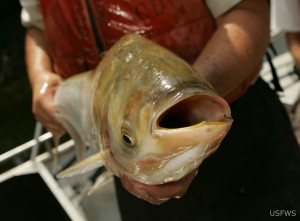We have much more to do and your continued support is needed now more than ever.
New Study: Asian Carp Are Clear Threat to Lake Erie
Asian carps could spawn and mature in Lake Erie and its tributaries.
That is the conclusion of a new U.S. Geological Survey (USGS) study, which further highlights the need for more aggressive actions to prevent the invasive fishes from entering the Great Lakes basin. The study found that tributary conditions and water temperatures are such that several Asian carp species could spawn and mature in the Lake Erie basin. With their prolific breeding rates and voracious appetites, Asian carps can cause significant ecological damage in waters they invade.
Current concern with entry points for Asian carps into the Great Lakes centers around the Chicago Area Waterways System (CAWS) as the most likely point of entry into Lake Michigan, with additional concern for other pathways, in particular Eagle Marsh near Fort Wayne, IN which can allow for fish passage between the headwaters of the Wabash River (in which Asian carp are already spawning in the lower reaches) and Maumee River watersheds during flooding.
The USGS study, led by Dr. Patrick Kocovsky, utilized data on temperature, flows, and flooding as well as modeling to predict whether Lake Erie tributaries were adequate for spawning (e.g., unobstructed stretches long enough for sufficient egg drift times, and temperatures warm enough for hatching). Their results are sobering:
- Nearly all the flood events in the Maumee, Huron and Grand Rivers in 1990-2009 would have been sufficient (i.e. length of passable river, predicted temperature and river velocities) to allow for hatching of Asian carp eggs;
- Additional analysis indicated the Maumee, Grand, and Sandusky Rivers would be most likely to support Asian carp spawning;
- Furthermore, based on western Lake Erie temperature data for 1990-2008, temperatures were adequate every year for growth and maturation of Asian carps.
Other Troubling Findings

If Asian carps established reproducing populations in western Lake Erie, they could cause significant harm to native species – bighead and silver carp could outcompete other plankton-consuming fish, and the grass carp (which consumes macrophytes, or larger aquatic plants) could cause harm to walleye and other native species reliant on macrophyte beds.
Establishment of Asian carps in Lake Erie would add another significant challenge to a system already reeling from other stresses, including nutrient loadings and harmful algal blooms, as we noted in the recent report Feast and Famine in the Great Lakes.
This latest study further highlights the need for even more aggressive efforts to prevent Asian carps from entering the Great Lakes, including an acceleration of the U.S. Army Corps of Engineers Great Lakes and Mississippi River Interbasin Study and efforts to re-establish the natural hydrologic separation between the Mississippi River and Great Lakes Basins. You can take action by supporting the Stop Asian Carp Act in Congress.
Further Information
The new USGS study in the Journal of Great Lakes Research
Information on the U.S. Army Corps of Engineers Great Lakes Mississippi River Interbasin Study
Further information on Asian carps from the Asian Carp Regional Coordinating Committee





















